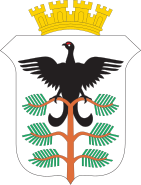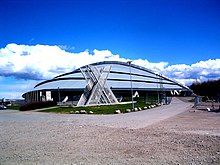Hamar
| coat of arms | map | |
|---|---|---|

|
|
|
| Basic data | ||
| Commune number : | 3403 | |
| Province (county) : | Domestic | |
| Administrative headquarters: | Hamar | |
| Coordinates : | 60 ° 48 ′ N , 11 ° 4 ′ E | |
| Height : | 130 moh. | |
| Surface: | 350.94 km² | |
| Residents: | 31,369 (Feb 27, 2020) | |
| Population density : | 89 inhabitants per km² | |
| Language form : | neutral | |
| Postal code : | 2306 | |
| Website: | ||
| traffic | ||
| Railway connection: |
Rørosbanen Dovrebanen |
|
| politics | ||
| Mayor : | Einar Busterud (By- og bygdelista) (2015) | |
| Located in the province of Innlandet | ||

|
||
Hamar is a city in Norway . It is the administrative center of the province ( Fylke ) Innlandet and has 31,369 inhabitants (as of February 27, 2020). Hamar is located on the east bank of Lake Mjøsa , about 130 kilometers north of Oslo .
history
The forerunner was a power center near Åker , at the junction of the important north-south connection from the inland settlements to the coast. It led across the Mjøsa along the Vorma and Glomma rivers . There was also traffic from Mjøsa towards Sweden. The names of the surrounding farms indicate that the area was a religious center. Here sacrifices were made and this is where people met for the thing . In addition, the importance of the site is reflected in numerous grave fields and large individual burial mounds. The largest is six meters high and 60 meters in diameter.
Hamar was founded in 1152 on Mjøsa as a bishopric . It was the only medieval city in Norway outside of the coastal regions.
The cathedral, monastery and school soon followed. For 400 years Hamar was one of the four to five central cities in Norway. The last Catholic bishop before the conquest of Hamar by the Danish general Truid Ulfstand in 1537 was Mogens Lauritsson .
In 1567 the cathedral was destroyed by the general of the Swedish King Erik , Johan Siggeson. As a result, most of the residents left the city. In 1587 the market was closed by royal order. Hamar lost its city status.
But in 1849 the city was rebuilt as an administrative and economic center according to a royal resolution. Towards the end of the 19th century, Hamar grew strongly, not least because of its strong food industry and the associated agriculture.
In 1992 the municipality of Vang was incorporated. Hamar has been a university town since Hedmark University was founded in 1994.
| Population development Hamar | |||||||||||||||
| year | 1951 | 1961 | 1971 | 1981 | 1991 | 1992 * | 1995 | 2000 | 2005 | 2010 | |||||
|---|---|---|---|---|---|---|---|---|---|---|---|---|---|---|---|
| Residents | 11,513 | 13,416 | 15,777 | 15,977 | 16,351 | 26,000 | 26,284 | 26,545 | 27,439 | 28,344 | |||||
* after merging with the municipality of Vang
Attractions

In addition to the Olympic Hall built for the 1994 Winter Olympics - better known as the Viking Ship ( Vikingskipet ) because of its shape - there are a number of other sights and museums:
- The Hedmark Museum
- Domkirkeodden with the ruins of the medieval cathedral
- New cathedral
- Norsk Jernbane Museum
- Hedmark. Museum and the ruins of the cathedral church
- the Emigration Museum (Norsk Utvandringsmuseum) about the history of emigration to North America
- DS Skibladner , the world's oldest paddle steamer still in operation, also known as the “white swan of Mjøsa”.
- Kirsten Flagstad Museum
- The modern town hall was designed by the internationally renowned architecture firm Snøhetta .
- Hamar Bispegard Museum (1967–1979), by the architect Sverre Fehn , winner of the Pritzker Prize in 1997
- Løiten Brænderi (old aquavit distillery)
- Norsk Motorhistorik Museum (Norwegian Museum of Motor History)
- Klevfoss Industrimuseum (Klevfoss Industrial Museum)
Transport and economy
The European route 6 , the most important south-north connection in Norway, runs east of the urban area . It runs from Trelleborg in Sweden via Oslo to the Norwegian-Russian border in Kirkenes and has been developed in sections as a motorway. The entire southern route from Trelleborg to Hamar has been developed as a four-lane motorway.
Hamar station is on the Dovre Railway , electrified since 1970 , which runs from Oslo to Trondheim . This is also where the Rørosbahn branches off, which also takes another route to Trondheim, but is not electrified.
In Hamar there is a production facility of the crispbread manufacturer Wasabröd .
Sports
Olympic games
During the Winter Olympics in 1994 in nearby Lillehammer (Klein Hamar), Hamar u. a. Venue for figure skating and speed skating.
Soccer
Hamar's football club Ham-Kam took third place as the best result in the Norwegian Tippeligaen in 1970 and made it to the semi-finals of the Norwegian cup competition several times.
ice Hockey
The ice hockey team Storhamar Hockey plays in the 1st Norwegian League (Elite Series).
Others
In the Vikingskipet , the “Viking ship” , numerous sporting events take place, such as the World Speed Skating Championships in 2013 and other events. Probably the most prominent example is the demo party The Gathering , one of the largest parties in the demo scene with over 5000 participants, which is held there every year over Easter.
Town twinning
|
|
|
sons and daughters of the town
Until 1950:
- Henrik Adam Brockenhuus (1720–1803), Danish nobleman
- Ludvig Skramstad (1855–1912), landscape painter
- Katti Anker Møller (1868–1945), women's rights activist
- Halfdan Bjølgerud (1884–1970), high jumper
- Kirsten Flagstad (1895–1962), singer (soprano), known for her Wagner interpretations
- Erik Waaler (1903–1997), physician, one of the discoverers of the rheumatoid factor
- Sigurd Evensmo (1912–1978), writer, screenwriter and film historian
- Kåre Walberg (1912–1988), ski jumper
- Rut Brandt (1920–2006), Norwegian-German author and second wife of German Chancellor Willy Brandt
- Odd Mæhlum (1921–2011), javelin thrower
- Randi Bratteli (1924–2002), journalist and non-fiction author
- Egil Danielsen (1933-2019), athlete (javelin thrower)
- John Erik Fornæss (* 1946), mathematician
- Dag Fornæss (* 1948), speed skater
- Bjørn Ianke (1948–2002), classical double bass player
From 1951:
- Espen Søbye (* 1954), philosopher and literary critic
- Jon Balke (* 1955), jazz pianist
- Nina Søbye (* 1956), racing cyclist
- Tom Martinsen (1957-2019), opera singer (tenor)
- Torill Kove (* 1958), Norwegian-Canadian animator
- Lars Anders Tomter (* 1959), violist and winner of international competitions
- Hilde Gjermundshaug Pedersen (* 1964), cross-country skier
- Jon Inge Kjørum (* 1965), ski jumper
- Vegard Skogheim (* 1966), football player and coach
- Helge Lien (* 1975), jazz pianist, composer and band leader
- Audun Grønvold (* 1976), skier
- Thorstein Helstad (* 1977), football player
- Trygve Slagsvold Vedum (* 1978), politician
- Vebjørn Berg (* 1980), marksman
- Anette Trettebergstuen (* 1981), politician
- Even Wetten (* 1982), speed skater
- Rannveig Haugen (* 1983), handball player
- Patrick Thoresen (* 1983), ice hockey player
- Jon Kristian Fjellestad (* 1984), organist and composer
- Marius Holtet (* 1984), ice hockey player
- Lars Løkken Østli (* 1986), ice hockey player
- Marcus Pedersen (* 1990), football player
- Gudmund Storlien (* 1990), Nordic combined athlete
- Sigurd Nymoen Søberg (* 1994), ski jumper




